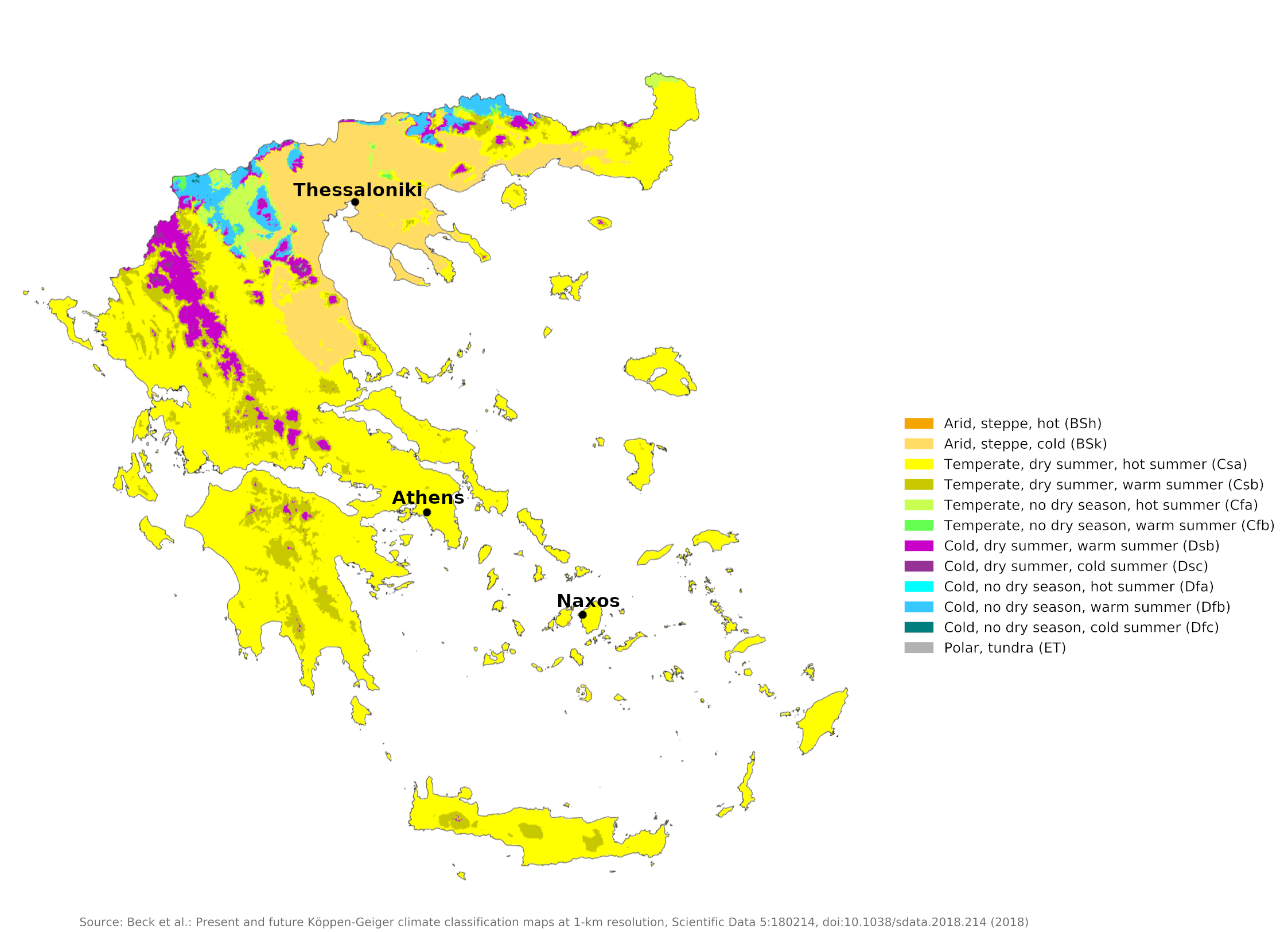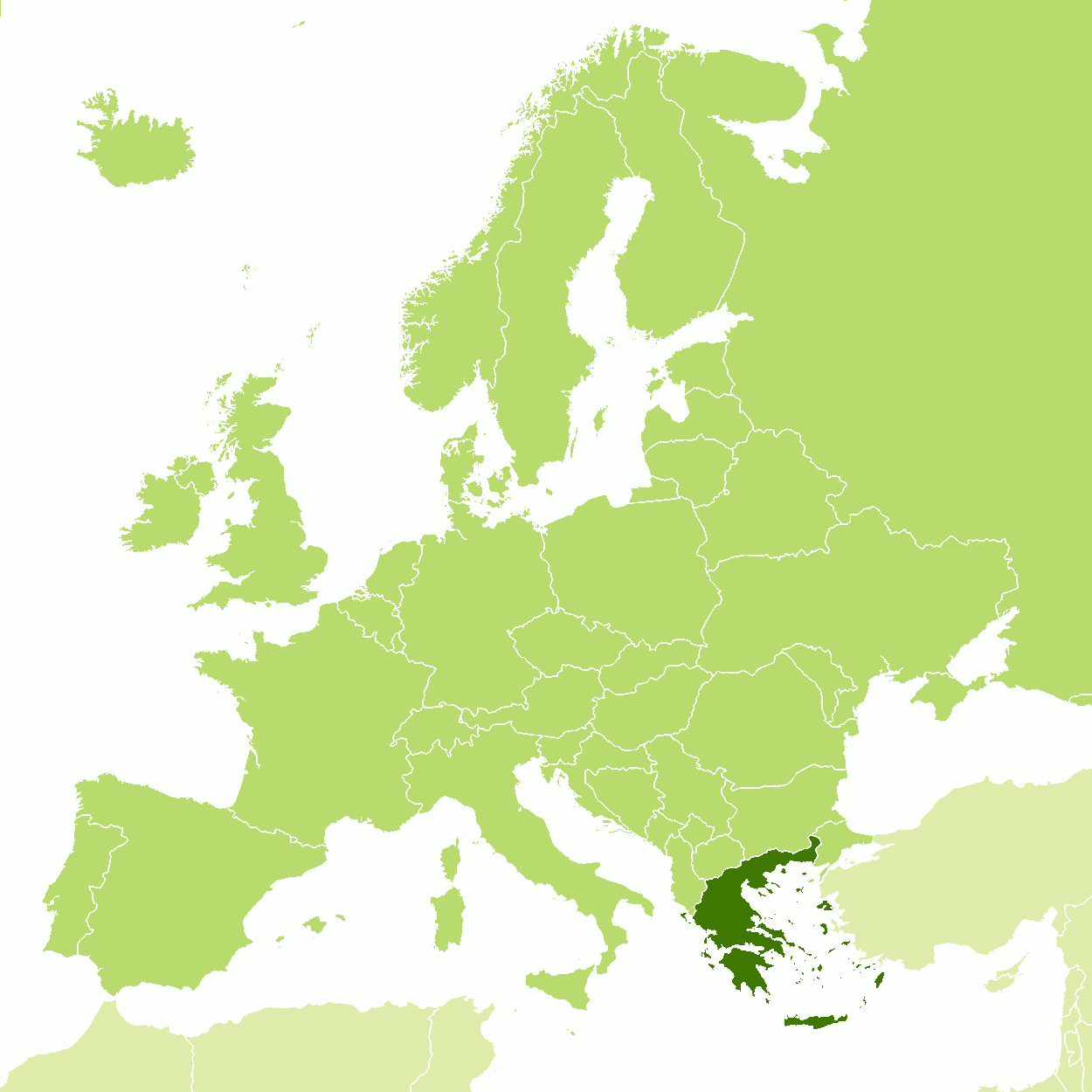The Climate of
Greece
 Agios Gordios, Corfu
Agios Gordios, Corfu
Climate Map
 Climate map of Greece
Climate map of Greece
What is the climate of Greece like?
Greece is located in the extreme southeast of Europe. It is a mountainous country with a heavily indented coastline and includes numerous islands in the Aegean Sea, the Ionian Islands to the west, of which Corfu is the best known, and the large island of Crete, which lies in the Mediterranean Sea. To the north, Greece shares land borders with Albania, North Macedonia, Bulgaria, and Turkey.
As a result of this blending of mountains, islands and sea, there are many local variations in weather and climate within the country, but the general weather conditions are pretty much the same throughout the year. Greece has a temperate Mediterranean climate, tempered by both sea and mountain breezes. Summers are hot and dry while winters are generally cool and rainy. The weather at higher elevations is colder and wetter.
In winter, low pressure systems from the North Atlantic reach Greece, bringing rain and milder temperatures, but also pulling cold winds from the eastern Balkans across Macedonia and Thrace as they enter the Aegean. The same low pressure areas also attract warmer winds from the south, creating an average January temperature difference of 4°C (7°F) between Thessaloniki at 6°C (43°F) and Athens at 10°C (50°F). Depressions bring mild winters and little frost to the lowlands in the west and south. From late autumn to winter, the Ionian Islands and the western mainland mountains receive copious amounts of rain (snow at higher elevations) from the west, while the eastern mainland, shielded by the mountains, receives much less rainfall. Thus, the average annual rainfall on Corfu off the west coast is 1,300 millimeters (50 inches); that of Athens on the south-eastern mainland is only 433 millimeters (17 inches).
In summer, the influence of low-pressure systems is much less, allowing for hot, dry conditions and an average sea level temperature of 27°C (80°F) in July. The Ionian and Aegean islands are particularly warm in October and November.
A prominent feature of the Greek climate is the large amount of sunshine. This varies from four to five hours a day in midwinter to twelve to fourteen hours a day in midsummer. In the mountains and in the extreme north, these amounts can be rather reduced. Rain tends to be heavy when it occurs and rarely lasts long except in the mountains or along the wetter west coast.
Around the coasts and on the islands, the summer heat is greatly alleviated by strong to fresh daily breezes, but very dry, hot winds have a drying effect causing drought in the Aegean region. On some occasions, however, when the air is calm, the daytime heat can be oppressive inland or in a large city like Athens. During the three summer months, a persistent north wind known as the Etesian blows in the Aegean and can occasionally reach almost gale force. It is strongest during the day and falls to an almost calm lull at night.
Summers are warm or even hot, with almost no clouds or rain for three months. The wettest season is winter, when the weather at sea level is generally mild, although occasional cold spells do occur. Snow can fall almost anywhere in Greece in winter, but is rare on the islands and does not stay at sea level for long. Spring and autumn are brief seasons of transition from winter rains to summer heat and sun, when the weather can be very changeable from day to day. For those who don't like heat, April and May or September or October are the most pleasant seasons in Greece.
At higher elevations inland, there is some rainfall throughout the year. In the mountainous regions of Greece, where many areas rise above 2,000 meters (6,500 feet), the weather can be severe in winter and even into spring, with frequent and heavy snowfalls and persistent frosts. Higher mountains in the southern Peloponnese and Crete are snow-capped for several months of the year. Here the summers are very pleasant as the days are sunny and often warm. The mountains of Macedonia and Thrace have colder continental winters, influenced by winds channeled through the river valleys from the north.
Eastern Greece is the driest part of the country and Athens is representative of much of eastern Greece with low values. Thessaloniki shows that in northern Greece the winters are a bit colder and the summers are not quite as rainless; Summer thunderstorms occur here. Conditions on the Aegean Islands and Crete are illustrated by Náxos; Here the winters are the mildest in the country and the summer heat is tempered by the sea breezes and persistent Etesian wind.
| Climate data for Athens (1991–2020) | |||||||||||||
|---|---|---|---|---|---|---|---|---|---|---|---|---|---|
| Month | Jan | Feb | Mar | Apr | May | Jun | Jul | Aug | Sep | Oct | Nov | Dec | Year |
| Average high °C (°F) | 13.3 (55.9) | 14.2 (57.6) | 17.0 (62.6) | 21.1 (70.0) | 26.5 (79.7) | 31.6 (88.9) | 34.3 (93.7) | 34.3 (93.7) | 29.6 (85.3) | 24.4 (75.9) | 18.9 (66.0) | 14.4 (57.9) | 23.3 (73.9) |
| Daily mean °C (°F) | 10.2 (50.4) | 10.8 (51.4) | 13.1 (55.6) | 16.7 (62.1) | 21.8 (71.2) | 26.6 (79.9) | 29.3 (84.7) | 29.4 (84.9) | 25.0 (77.0) | 20.3 (68.5) | 15.6 (60.1) | 11.6 (52.9) | 19.2 (66.6) |
| Average low °C (°F) | 7.1 (44.8) | 7.3 (45.1) | 9.2 (48.6) | 12.3 (54.1) | 17.0 (62.6) | 21.6 (70.9) | 24.2 (75.6) | 24.4 (75.9) | 20.4 (68.7) | 16.2 (61.2) | 12.2 (54.0) | 8.7 (47.7) | 15.0 (59.0) |
| Average precipitation mm (inches) | 55.6 (2.19) | 44.4 (1.75) | 45.6 (1.80) | 27.6 (1.09) | 20.7 (0.81) | 11.6 (0.46) | 10.7 (0.42) | 5.4 (0.21) | 25.8 (1.02) | 38.6 (1.52) | 70.8 (2.79) | 76.3 (3.00) | 433.1 (17.06) |
| Source: Cosmos, National Observatory of Athens | |||||||||||||
| Climate data for Thessaloniki | |||||||||||||
|---|---|---|---|---|---|---|---|---|---|---|---|---|---|
| Month | Jan | Feb | Mar | Apr | May | Jun | Jul | Aug | Sep | Oct | Nov | Dec | Year |
| Average high °C (°F) | 9.3 (48.7) | 11.0 (51.8) | 14.3 (57.7) | 19.1 (66.4) | 24.6 (76.3) | 29.4 (84.9) | 31.7 (89.1) | 31.4 (88.5) | 27.1 (80.8) | 21.2 (70.2) | 15.5 (59.9) | 10.9 (51.6) | 20.5 (68.8) |
| Daily mean °C (°F) | 5.4 (41.7) | 6.8 (44.2) | 9.8 (49.6) | 14.3 (57.7) | 19.9 (67.8) | 24.7 (76.5) | 26.9 (80.4) | 26.4 (79.5) | 21.9 (71.4) | 16.5 (61.7) | 11.3 (52.3) | 7 (45) | 15.9 (60.7) |
| Average low °C (°F) | 1.5 (34.7) | 2.3 (36.1) | 4.7 (40.5) | 7.9 (46.2) | 12.6 (54.7) | 17.0 (62.6) | 19.3 (66.7) | 19.1 (66.4) | 15.4 (59.7) | 11.3 (52.3) | 7.1 (44.8) | 3.2 (37.8) | 10.1 (50.2) |
| Average precipitation mm (inches) | 37.7 (1.48) | 35 (1.4) | 37.9 (1.49) | 36.1 (1.42) | 44.2 (1.74) | 29.8 (1.17) | 23.8 (0.94) | 19.3 (0.76) | 29.8 (1.17) | 43.0 (1.69) | 52.8 (2.08) | 55.1 (2.17) | 444.5 (17.51) |
| Source: Hellenic National Meterological Service | |||||||||||||
| Climate data for Naxos | |||||||||||||
|---|---|---|---|---|---|---|---|---|---|---|---|---|---|
| Month | Jan | Feb | Mar | Apr | May | Jun | Jul | Aug | Sep | Oct | Nov | Dec | Year |
| Average high °C (°F) | 14.3 (57.7) | 14.4 (57.9) | 15.7 (60.3) | 18.6 (65.5) | 21.9 (71.4) | 25.7 (78.3) | 26.6 (79.9) | 26.2 (79.2) | 24.6 (76.3) | 21.4 (70.5) | 18.6 (65.5) | 15.8 (60.4) | 20.3 (68.5) |
| Daily mean °C (°F) | 12.0 (53.6) | 12.1 (53.8) | 13.3 (55.9) | 16.1 (61.0) | 19.4 (66.9) | 23.2 (73.8) | 24.7 (76.5) | 24.4 (75.9) | 22.6 (72.7) | 19.3 (66.7) | 16.2 (61.2) | 13.7 (56.7) | 18.1 (64.6) |
| Average low °C (°F) | 9.3 (48.7) | 9.3 (48.7) | 10.2 (50.4) | 12.5 (54.5) | 15.4 (59.7) | 19.2 (66.6) | 21.7 (71.1) | 21.7 (71.1) | 19.8 (67.6) | 16.6 (61.9) | 13.4 (56.1) | 10.9 (51.6) | 15.0 (59.0) |
| Average precipitation mm (inches) | 71.3 (2.81) | 58.6 (2.31) | 49.8 (1.96) | 18.4 (0.72) | 9.8 (0.39) | 2.8 (0.11) | 0.6 (0.02) | 2.8 (0.11) | 5.7 (0.22) | 39.3 (1.55) | 47.4 (1.87) | 69.4 (2.73) | 375.9 (14.80) |
| Source: NOAA | |||||||||||||
When is the best time to visit Greece?
Greece has a mild Mediterranean climate with over 300 days of sunshine a year. February has the most rain. South of Athens and on the islands the weather is ideal 10 months of the year; elsewhere spring and fall are best.
References
- E. A. Pearce, Charles Gordon Smith, (1990) The Hutchinson World Weather Guide, John Murray Press. ISBN 1859863426
- Timothy L. Gall, (ed.), (2003), Worldmark Encyclopedia of the Nations, Eleventh Edition, Thomson Gale
- Federal Research Division, Library of Congress, (1995), Greece: a country study. Claitor's Pub. Division. ISBN 0844408565
- Hugh Chisholm, (ed.), (1911), Encyclopædia Britannica, Eleventh edition, Cambridge University Press
The Climate of
Greece

In summary:
Greece has a temperate Mediterranean climate moderated by both sea and mountain breezes. Summers are hot and dry, while winters are generally cool and rainy. The weather at the higher elevations is colder and wetter. The mean temperature of Athens is 19°C (67°F), ranging from a low of 7°C (45°F) in the winter to a high of 34°C (94°F) in the summer.
Rainfall is heaviest in the north and in the mountains. Average annual rainfall varies from 500 to 1200 mm (20–48 in) in the north and from 380 to 810 mm (15–32 in) in the south.